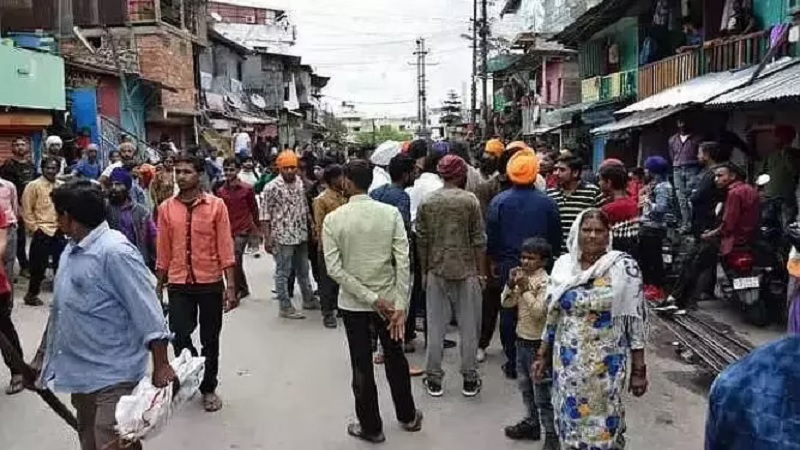 Image Courtesy:sentinelassam.com
Image Courtesy:sentinelassam.com
On October 30, the Government of Meghalaya took over the land on which stands Punjabi Lane, a settlement of Dalit Sikhs. It did so by paying a sum of Rs 2 crore to Syiem of Hima Mylliem, the local chieftain, for the land spread over 12,000 sq meters.
Mylliems are 54 traditional administrative territories under the Khasi Hills Autonomous District. Each ylliem has a Syiem or Chief. Punjabi Lane, also known as Harijan Colony, is located in the Duh area of the state capital, just a stone’s throw from Bara Bazaar in Them lew Mawlong. The inhabitants are at least 300 families of Dalit Sikhs whose ancestors were brought to the state by the British to work as conservancy workers. Even today, many of them work in the Shillong Municipality.
As per official records, 184 employees and their families have been identified as legal settlers. This includes 128 are employees of the Shilling Municipal Board (SMB) and 56 of other departments in the government. These families are eligible for relocation to staff quarters. But what happens to the others? There are many families where descendants of conservancy workers moved out of their traditional area of work and set up small shops or entered the service industry. Why are they suddenly deemed “illegal settlers”?
With the state government is poised to evict Dalit Sikh families from Punjabi Lane, let us take a look at the events that led to this moment.
Dalit Sikhs in Meghalaya
The British originally brought Dalit Sikhs to the region. These include the Mazhabis, the Ramgarhias and Soniars, who engaged in a variety of activities and trades ranging from conservancy work to carpentry to metal work. The Sikhs claim that the land upon which their ancestors built this settlement was gifted to them by the then Syiem of Hima Mylliem. Interestingly, laws in Meghalaya ban non-tribals from owning property in scheduled areas.
This land dispute came to prominence over the last three decades, as socio-political organisations and a section of society grew opposed to prime commercial land being used for residential purposes. Some blamed it for traffic congestion, others pushed for it to be cleared to make way for a parking lot or a shopping complex.
But things came to a head when clashes broke out in May 2018. An altercation between some women from Punjabi Lane and a bus driver got out of hand and rumours circulating on social media sparked riots between local Khasis and Sikh residents in the area. The following month Meghalaya Chief Minister Conrad Sangma ordered the setting up of a High Level Committee (HLC) to settle the land dispute. This HLC submitted its report in which it recommended that the residents of Punjabi Lane be relocated. But the Harijan Panchayat Committee (HPC) rejected this recommendation. HPC had at that time issued a statement saying, “We will fight tooth and nail” and that they had “rejected the report”.
Shortly afterwards the HPC moved the Meghalaya High Court in the matter and in February 2019, the HC ruled that it was a “civil” matter and needed to be addressed in a civil court.
Fresh developments in the case
In April, 2021, the Meghalaya High Court had ordered that the state government and the HPC maintain status quo with respect to the Punjabi Lane land dispute. But on October 7 this year, the Meghalaya Cabinet decided to acquire the land and relocate the settlers. The Chief Minister explained, “The Committee also recommended shifting of the permanent municipal employees, who are currently residing in the Colony to the quarters that have been constructed. Further, we will request the other residents residing in the Colony to shift to the designated locations.”
Subsequently a tripartite agreement was signed between the Department of Urban Affairs (DUA), the Shillong Municipal Board (SMB) and the Syiem of Hima Mylliem. As far as relocation goes, 128 employees of the SMB and their families will be relocated to staff quarters built for the purpose. These quarters are located on Bishop Cotton Road, the original location of the SMB offices. As per the recommendations of the HLC, these offices were to be shifted to a temporary location at the old MBDA office.
This leaves families of 56 employees of other departments, though some of them have reportedly moved out of Punjabi Lane to different locations already. Those who haven’t will be accommodated in other designated locations identified by the DUA and the respective departments in the SMB. But this only accounts for 184 families and the neighbourhood is home to at least 300 families. What happens to the remaining 116 families? The Chief Minister’s response was rather cryptic, “Urban Affairs Dept. will explore other locations after which the Govt. will take a call.”
After the land was taken over by the government, Gurjit Singh, secretary of the HPC told Outlook, “We will give sleepless nights to the government!” The HPC plans to petition the governor as well as approach the National Human Rights Commission (NHRC), National Commission for Minorities (NCM) and the National Commission for Safai Karamcharis (NCSK).
He went on to say, “The tripartite agreement between the Government of Meghalaya, the Acting Syiem of Hima Mylliem and the Shillong Municipal Board is illegal, malafide and a clear violation of the constitutional and fundamental rights of the residents of Punjabi Lane, whose forefathers came here some 200 years ago and who have served Meghalaya honestly and diligently doing manual scavenging and other menial tasks.”
Related:
Meghalaya: Four arrested in Bara Bazar ethnic violence case
Turmoil in the North East: Ethnic divide widens in Meghalaya